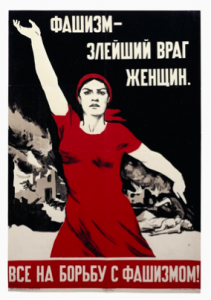Nina Vatolina- Fascism, the most evil enemy of Women, Poster- 1941
Nina Vatolinas imagery is scattered with depictions of empowered women. It is clear to see why this is one of the most famous Soviet posters of this time period. The simple but bold palette, high contrast and sharp text really makes the work stand out. The fluid movement of the figure is emphasized by the fluidity of the dress and the background. This draws the eye in from across the room and encourages the eye to scan the image. I have seen this specific poster before online and in books, and after seeing it in the flesh the two do not compare. Through second hand images the colours are not quite right, in person the red is extraordinarily deep and vibrant, whereas online it often has an orange tint to it. in person the contrast was also much clearer, which quite possibly was down to the large scale of the poster. This is the primary purpose of a propaganda poster such as this; firstly to draw attention, then to inspire. The emotive features of the face emanate with calm confidence and sureness. Personally, I feel inspired by this work, not by the political message that it flaunters but of the sheer hard working determination that the figure shows. If we take away from the overall message and pull out the figure alone, we get a depiction of a strong, hard working but also naturally beautiful women, something that most women, especially at the time, would aspire to be. This strikes a stark contrast to the representation in the background; a woman weeps over her, presumably, dead husband and child. This contrast is accentuated by the tonal values throughout the image. This seemingly represents the horror of which the fascists will ensue, and the red woman, representing the soviets, rising above stronger and more determined than before. (The two women could almost be seen as the same person but in different time frames). I have found that this contrast between this despair and unparalleled confidence is quite common in propaganda posters of the time; this includes Nazi propaganda. This intrigues me as the posters are admitting to extreme hardships and then smothering them in positive imagery. I suppose, in a way, it was impossible for the governments to cover up the poverty and hardship with positive imagery alone, as nearly all of the general public was experiencing the same hard times.

